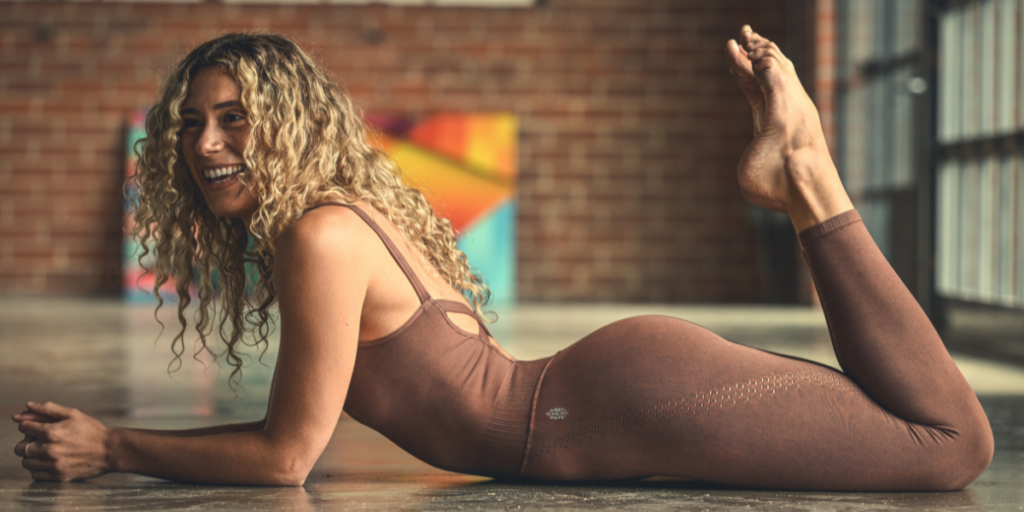How to Practice Bow Pose and Its Benefits

Bow Pose, also known as Dhanurasana, is a powerful yoga posture that offers numerous benefits for the body and mind. This blog entry will guide you through the practice of Bow Pose, explain its energetic and physical benefits, and highlight important contraindications to consider.
To practice Bow Pose, follow these steps:
- Start by lying on your belly with your forehead resting on the mat and your arms
- alongside your body, palms facing down to open the shoulders.
- Align your body to prevent strain or injury. Ensure that your feet and ankles are parallel and even.
- Lengthen your tailbone toward your feet while gently rolling your inner thighs upward. Engage your lower abdominal muscles and maintain length in your spine.
- Bend your knees and reach your arms back, turning your palms to face each other. Grab hold of your ankles.
- Inhale deeply as you lift your chest and thighs evenly off the ground. Simultaneously, kick your legs back into your hands while maintaining equal pressure on both sides of the pelvis.
- Engage your entire body in this posture, especially activating your back muscles and core to support the backbend.
- Imagine everything being drawn towards the midline, while elongating your spine from the base to the crown.
- Keep your shoulders and gaze relaxed and forward, maintaining a steady breath throughout the pose.
- Stay soft and open, holding the posture for at least 5 breaths.
Here are some additional suggestions to enhance your Bow Pose practice:
Warm-up: Before attempting Bow Pose, warm up your body with gentle stretches and movements, focusing on opening the chest, shoulders, and hip flexors.
Props: If reaching your ankles is challenging, use a yoga strap or a towel looped around your ankles for support. Alternatively, actively reach for your feet with your hands. If these options are not available, imagine reaching for your feet. Placing a block between your inner ankles can help maintain lower back alignment and protect the lumbar spine from compression.
Variation: If you can’t fully lift your thighs off the ground, start with a modified version by lifting only the chest. This variation, known as Half Bow Pose, still offers benefits while gradually building strength and flexibility. Another option is to practice Locust pose, which shares foundational elements with Bow Pose. If you are pregnant or have contraindications for prone backbends, consider practicing similar backbends like Camel Pose or Bridge Pose. Both variations open the chest and lengthen the spine, just like Bow Pose.
Breath Awareness: Pay attention to your breath during Bow Pose, breathing deeply and consciously to support your movements. Maintain a steady and relaxed breath for an enhanced experience.
Rest and Recovery: After practicing Bow Pose, rest in a neutral position such as Child’s Pose or Corpse Pose to integrate the benefits and allow the body to recover. Take a few moments to pause and feel the unique effects that the asanas have on your body. This is an opportunity to learn more about your body and yourself.
Remember to practice Bow Pose mindfully and listen to your body. If you experience any discomfort or pain, modify the pose or ease out of it. There are always options to adapt the practice to fit your needs.
Approach Bow Pose with curiosity and exploration, focusing on the sensations and feelings that arise during the pose, rather than striving for a specific shape or outcome. Your breath is your guide. Allowing the breath to deepen and expand within the pose will create more space and freedom in your body. With curiosity and presence, this posture can bring about more strength, flexibility, and a deeper sense of inner awareness. Trust that the nature of your backbend will gradually deepen over time. It’s important to practice Bow Pose with care, respect for your body’s limitations, and a focus on the internal experience rather than external appearance. Approach the posture and yourself with patience and compassion.
When you approach a posture in this way, you can more readily receive the benefits it has to offer. Bow Pose has a wide range of benefits for both the energetic and physical body. Energetically, it stimulates and balances the Heart and Solar Plexus chakras, promoting feelings of openness, love, empowerment, and self-confidence. Physically, Bow Pose strengthens the back muscles, stretches the entire front body including the hip flexors and abdomen, improves posture, opens the shoulders and chest, enhances lung capacity, promotes deep breathing, and stimulates digestion. The nature of this asana connects you to your entire body, creating a sense of wholeness and grounded expansion that extends beyond the mat.
Bow Pose is a posture to cherish that can greatly benefit both the body and mind. Whether you are a beginner or an experienced yogi, incorporating Bow Pose or variations of it into your practice can improve flexibility, strength, posture, and overall well-being. Approach the pose with awareness and allow your focus to be on the internal experience — this is where the posture becomes most impactful. Practice with curiosity, patience, and compassion, allowing these intentions to gradually deepen your practice of Bow Pose over time.
Enjoy exploring Bow Pose and experiencing its incredible benefits!
Read this, thinking no way, as a 62 year old woman with many health issues no easy will I do able to do this! But where does a non active , kind unhealthy woman begin?
Thanks
Alice
Thanks for sharing great article on yoga works. Helpful for health conditions now a days